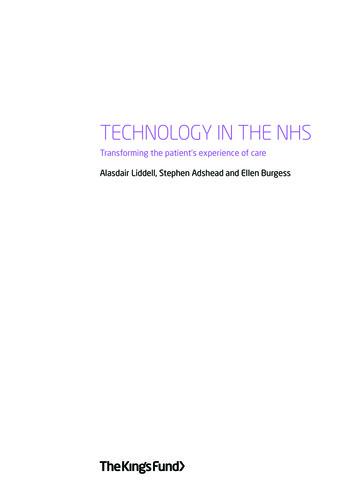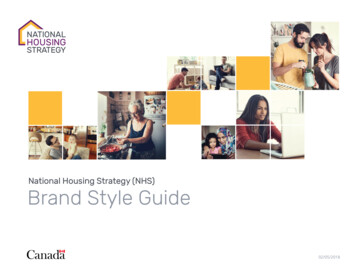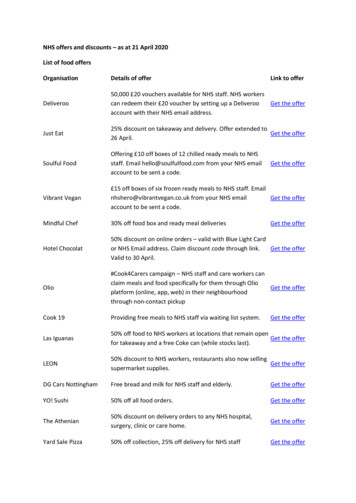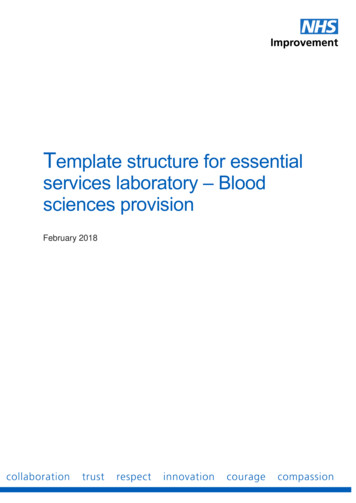
Transcription
Technology in the NHSTransforming the patient’s experience of careAlasdair Liddell, Stephen Adshead and Ellen Burgess
The King’s Fund seeks tounderstand how the healthsystem in England can beimproved. Using that insight, wehelp to shape policy, transformservices and bring aboutbehaviour change. Our workincludes research, analysis,leadership development andservice improvement. We alsooffer a wide range of resourcesto help everyone working inhealth to share knowledge,learning and ideas. The King’s Fund 2008First published 2008 by The King’s FundCharity registration number: 207401All rights reserved, including the right of reproduction in whole or in part in any formISBN: 978 1 8571 75745A catalogue record for this publication is available from the British LibraryAvailable from:The King’s Fund11–13 Cavendish SquareLondon W1G 0ANTel: 020 7307 2591Fax: 020 7307 2801Email: publicationsEdited by Fiona WestonTypeset by Andrew Haig & AssociatesPrinted in the UK by The King’s Fund
Contents The King’s Fund 2008List of figures and tables vAbout the authors and acknowledgements viSummary vii1 Introduction 1Context Objectives and structure of the report Our approach Scope and definitions 13332 The ideal scenario 5The ‘age of abundance’ scenario Consumer health care needs The supply of health care technologies The impact of the use of technology in health care 6710103 The adoption of technology in health care 14The framework of factors influencing the adoption of technology External supply-side factors External demand-side factors Factors internal to the health service 141517194 Technology adoption models 25Top-down, policy-led uptake Uptake within local management Uptake by professionals within the NHS Uptake by consumers Conclusion – the key barriers to adoption 25272930315 Recommendations – how to achieve the ideal vision 33Introduction National leadership Local performance Funding mechanisms Better management of the trial process Better communication with consumers 333334343535
Strengthening the NHS/industry partnership 35Appendix A Learning from other sectors 36Appendix B Technologies in the ideal scenario, 2018 40Appendix C46References Workshop participants and interviewees 47 The King’s Fund 2008
List of figures and tablesFigure 1 Scenario development methodology (Ofcom study) The King’s Fund 20086Figure 2 Simplified model of the adoption of technology 14Figure 3 Factors affecting the adoption of technology in health care 15Figure 4 Simplified model of key factors within the NHS that influence theadoption of technology 19Figure 5 Technology adoption model 1 – top-down, policy-led uptake 26Figure 6 Technology adoption model 2 – uptake within local management 27Figure 7 Technology adoption model 3 – uptake by professionals within the NHS 29Figure 8 Technology adoption model 4 – uptake by consumers 31Table 1Consumer needs 8Table 2Examples of health care technologies in the ideal scenario 9Table A1 Comparison of technology uptake across sectors 37Table B1 Technology to provide information and advice in the ideal scenario 41Table B2 Technology to cater for administration and transactions in theideal scenario 41Table B3 Technology to meet the need for diagnosis in the ideal scenario 42Table B4 Technology to meet the need for consultations and clinical care in theideal scenario 42Table B5 Technology to meet the need for monitoring in the ideal scenario 44v
About the authorsThis study was conducted by a multidisciplinary team of ?What If! consultants withexpert advice from Alasdair Liddell.Alasdair Liddell is an independent expert on the health sector. He acts as an associate of?What If!, closely involved in ?What If!’s health practice. He is also a Senior Associate atThe King’s Fund, is a director of an AIM-listed health-sector company, and acts as healthadviser to a number of technology and service companies. His previous career includessix years in the Department of Health as National Director of Planning for the NationalHealth Service (NHS) with board-level responsibility for strategy and priorities, NHSinformation and information technology, NHS communications, and a number of keypolicy areas including primary care. He was responsible for the development and launchof NHS Direct, and led the team preparing New Labour’s first White Paper, The NewNHS: Modern, dependable, which laid the foundations and structure for the current NHSreform programme. He was a member of the top management board of the NHS for 12years, between 1988 and 2000. His earlier career included 23 years in NHS management,12 of them as chief executive of district and regional health authorities.Stephen Adshead is a Senior Consultant at ?What If!, with nearly 10 years’ experience instrategic consulting and analysis in the broadcast, telecommunications and technologyindustries. Stephen focuses on supporting media companies, telecommunicationsoperators and regulators in understanding and exploiting the opportunities presentedby digital media. Prior to joining ?What If!, Stephen held a senior position at ChrysalisTelevision Group (ALL3MEDIA), the UK’s largest independent television productioncompany, where he led the development of the company’s interactive television strategy.Stephen holds a first class degree in Chemistry from Cambridge University.Ellen Burgess joined ?What If! from medical device company Stryker Corporation, whereshe was working in the Europe, Middle East and Africa division’s marketing headquartersin Switzerland. Ellen was responsible for several projects, including a sales representativetraining scheme, a customer insight programme, and a rebranding campaign. Ellen holdsa degree in Natural Sciences and Management Studies from Cambridge University.AcknowledgementsWe would like to thank NHS Direct for its invaluable support with this project.For the last 10 years NHS Direct has delivered 24-hour health advice and informationthrough a range of innovative technologies. NHS Direct has developed a national ICTinfrastructure from which to deliver its 0845 4647 telephone advice and informationservice. Its website receives over 3 million visits each month. NHS Direct was the firstpublic sector or health care service to embrace interactive digital TV technology withservices now available on both Sky and Freeview.vi The King’s Fund 2008
SummaryDespite the potential benefits of technology, it is generally acknowledged that its adoptionwithin the health care sector is slow and disparate. The Healthcare Industries Task Force,for example, described the National Health Service (NHS) as ‘a late and slow adopter oftechnology’ (Healthcare Industries Task Force 2004).The NHS Next Stage Review interim report in 2007 emphasised the importance oftechnology in the NHS and highlighted the role that technology can play in improvinghealth outcomes (Department of Health 2007b), but much remains to be done to giveeffect to the aspirations set out in the final report, High Quality Care For All (Departmentof Health 2008a), and the associated regional plans.The study we have undertaken builds on current work in this area, and aims to improvethe uptake of useful consumer-facing technology in health care by analysing the mainbarriers to adoption and suggesting measures to overcome them.We begin (Chapter 2) by describing an ideal scenario for the adoption of technologyin health care, looking ahead over the forthcoming decade to illustrate its potential tocontribute to better clinical outcomes, to improve the patient experience and to provideeconomic benefits.We give examples of the kind of technologies that might be available (although few ofthese are actually dependent on all the features of the ideal scenario).The main part of our report, Chapter 4, analyses the principal factors, both positive andnegative, that influence decisions to adopt technology, including the following. The King’s Fund 2008The ability of the vendors of technology to build an investment case and attractfunding Core to this is the perceived market opportunity within the NHS. This isoften seen as being unattractive due to the complex selling process and the diversityof buying points.The level of engagement between technology suppliers and the NHS Thecommissioning process within the NHS is seen as fragmented and complex, andvaries between commissioning groups. Every commissioning group has a differentset of requirements against which it assesses new business cases for technologies.The availability of agreed technology standards These are essential, especiallywhere interoperability is important.Consumer awareness of technology and understanding of the benefits that it canbring Consumer demand is an important driver for the adoption of technologyas consumers become more empowered and more demanding about the kinds oftreatment they want.Consumer concerns about confidentiality and usability This concern might begreater than the real level of risk, but it remains a significant barrier to uptake.vii
Technology in the NHS Government policy Policy can have an impact on the adoption of technology eitherdirectly, by setting guidance or targets, or indirectly, by setting objectives that couldbe met via technology.Management leadership and direction Strong leadership is required at nationaland local level to create a climate in which local managers feel encouraged toparticipate in the testing of technology solutions, and to adopt them where positiveoutcomes have been demonstrated.Structures to assess and trial technology and encourage adoption, such as theNational Institute for Health and Clinical Excellence (NICE), the NHS NationalInnovation Centre (NIC), and the innovation hubs If working well, thesemechanisms act as filters for new technology and then as catalysts for adoption.Efficiency of information sharing within the health service Technologicalinnovations will spread most effectively within the health service if the flow ofinformation about them is free and efficient, so that potential buyers and users knowabout the technologies, their potential benefits and how to implement them.Effectiveness of procurement and decision-making The procurement processwithin the NHS is highly complex, presenting many barriers to the adoptionof technology. These include multiple points of sale, extended and complexprocurement processes, and a tendency to focus on ‘least cost’ rather than ‘best value’.Resources: funding and people The availability of resources, both financial andorganisational, affects the ability of the health service to change across the range ofits activities, including the use of technology.Chapter 4 reviews the various models for the adoption and dissemination of technology,from the ‘top-down’, centrally mandated approach, through local management-driveninitiatives and uptake by professionals, to uptake by consumers. The main barriers toadoption across these models are identified as: lack of resources (people, management and funding)lack of leadership from the centre (potentially remedied by the new commitments toinnovation in High Quality Care For All [Department of Health 2008a])a tendency to assess new technologies on a ‘least cost’ rather than ‘best value’ basisthe requirement to manage a change in service strategy that may be enabled ornecessitated by a new technologythe complexity of the decision-making process, the diversity of buying points, andthe inability of commissioners to take a sufficiently long-term view.Chapter 5 sets out our recommendations. These are as follows.RecommendationsNational leadership The Department of Health should provide clear, consistent and sustained Ministerialand Board level leadership on the use of technology in health care. In this regard, themain leadership roles of the department include:–– supporting the recently established Health Innovation Council, which bringstogether key health sector technology interests, and ensuring its recommendationsare implementedviii The King’s Fund 2008
Summary–– co-ordinating the activities of the various national bodies and agencies that have atechnology remit, including the NHS Institute for Innovation and Improvement,the NIC, NHS Connecting for Health, the National Programme for IT (NPfIT),the NHS research and development (R&D) programme, and the local innovationhubs–– ensuring that the appropriate use of technology is considered an integral part ofall policy development within the department–– ensuring that active steps are taken to increase and accelerate the technologyassessments carried out by NICE, to implement the results, and to roll outtechnologies from successful trials–– reviewing national procurement processes to ensure they are structured tofacilitate the uptake of innovation and the adoption of appropriate technology,based on a ‘best value’ approach–– consolidating access to central pump-priming, R&D and innovation funding toprovide a ‘one-stop shop’ for the funding of new technology–– developing a ‘manifesto’ for the use of technology in the NHS, perhaps includinga list of ‘10 high-impact changes’ for technology, as proposed by the NHSModernisation Agency (2004).Local performance There is a number of mechanisms for ensuring that the adoption of innovation andtechnology remains high on the agenda for local NHS organisations, not the least ofthese being the new legal duty on strategic health authorities to promote innovation,announced in High Quality Care For All (Department of Health 2008a), and theannual NHS Operating Framework, which sets out the national priorities for thecoming year (Department of Health 2007c).Convenience and access are important outcomes. The extent to which localpublic services use innovation and technology to improve the customer experienceand provide more convenient access to services should be routinely measuredand reported.The new Comprehensive Area Assessment (CAA) process seeks to provide anannual, holistic, independent assessment of the prospects for local areas and thequality of life of people living there. The answer to the central question posedby the CAA – ‘what is it like to live in my area?’ – must, of course, deal with keyrequirements such as safety, access to employment, education, housing and freshfood; but it could also look at how technology and innovation is improving thequality of life by providing better and more convenient access to public services,enabling and supporting healthy living, and enabling treatment and care to bedelivered at or closer to home, especially for older people and those living with longterm conditions who otherwise might have to be cared for in an institutional setting.Funding mechanisms The King’s Fund 2008Commissioners and providers should recognise that investment in technologymight have relatively long timescales for payback, and must manage the investmentfunding accordingly.Transition funding for the adoption of new technologies should be made available atnational, regional and local levels in order to cover short-term implementation andix
Technology in the NHSdouble running costs. Funding could be in the form of a loan, repayable on the basisof an agreed schedule. Commissioners should take the lead in ensuring that the effects of ‘silo budgeting’(where the costs and benefits of implementing technology fall to different budgets)do not inhibit the adoption of appropriate technology. This would normally takethe form of adjusting provider contracts to shift resources from a provider makingsavings to one incurring costs as a result of the adoption of technology.The Department should consider steps to limit the adverse effects of silo budgetingon the adoption of technology as part of its regular review of Payment by Results.Better management of the trial process NICE’s technology assessment programme can address only a limited number of newtechnologies (although we have recommended an increase in its capacity to undertakeassessment of technology). There need to be more informal mechanisms for assessingthe costs, benefits and risks of new technologies, which could then be subject to postimplementation evaluation to confirm or revise the initial assessment.Before a trial of technology is undertaken, there should be a mechanism that ensuresthat the trial adds value to the existing technology landscape. This could be overseenby the regional innovation hubs.The trial manager should provide commitment that the trial will both contributetowards the evidence base and be appropriately acted on.Better communication with consumers NHS trusts, primary care trusts (PCTs), managers and clinicians should activelycommunicate the benefits of and promote the use of technologies that canimprove patient outcomes and patient experience (including those that offer moreconvenient access to and transactions with the health system).Clinicians – in hospitals and community settings – should encourage patientsto make full use of the technology available, for information, transactions andmonitoring where this is appropriate to their condition.Technology (especially consumer-facing technology) should be targetedappropriately to ensure maximum uptake. This will mean initially targeting thosemost likely to embrace the service (for example, as a result of information technologyliteracy, value or convenience). The aim should be to develop a critical mass of userssufficient to generate a ‘viral marketing’ effect to drive uptake on a wider basis.Strengthening the NHS/industry partnership xThe NHS Institute and NIC should provide industry with accurate and up-to-dateadvice about how and where to present its business case for new technology in orderto maximise the adoption of technologies that can benefit patients and the public.Those seeking to sell their technologies to the NHS should develop an evidencebased business case that demonstrates value in terms that are relevant to thepurchasing decision-maker.The NIC should run a series of ‘showcase events’ on a rolling basis, targeting not justthose interested in technology and innovation, but a wider range of potential clinicaland management decision-makers. The King’s Fund 2008
1 IntroductionContextDemographic changes are placing an increasing burden on the health service. An ageingpopulation and an increase in chronic disease and in behaviours that are detrimental tohealth mean that there is an increasing demand for health care services. In his first reviewof future spending, Sir Derek Wanless concluded that over the next 20 years the UnitedKingdom (UK) would need to devote substantially more resources to its health care systemin order to ensure high-quality services that meet public expectations (Wanless 2002).In a more recent report, Sir Derek concluded that technology and medical advanceshad contributed around two percentage points to the annual rate of growth of healthspending over the previous 20 years, and suggested that over the next two decadesspending on technology would need to grow at an even faster rate to catch up – andkeep up – with that of other countries (Wanless 2007). The European Commission hasalso called for a ‘new health care delivery model [which] can only be achieved throughthe proper use of [information and communication technologies], in combination withappropriate organisational changes and skills’ (European Commission 2006).The importance of technology and information technology (IT) systems in meetingthe challenges placed on the health care system is becoming increasingly apparent.In 1998, recognising the changing nature of technology – and its increasing potentialfor interconnectivity – the then National Health Service (NHS) Executive publishedInformation for Health: An information strategy for the modern NHS 1998–2005(Department of Health 1998a). This strategy laid the groundwork for more recentinitiatives, and set out a commitment to develop the following: electronic health records, providing round-the-clock access to summaryinformation about the care of individual patientselectronic patient records, built to common standards, recording more detailedinformation about the treatment and care of patients within hospitalsa technical infrastructure, including an NHS-wide network, a dictionary of clinicalterms and a strategic messaging serviceimproved clinician and public access to evidence-based health and health careinformation, through the National Electronic Library for Health and NHS Directguidelines to promote the greater use of telemedicine and telecare.The National Programme for IT (now called Connecting for Health) was formallyestablished in 2002, with a renewed commitment to replacing the fragmented approachto NHS IT with standardised interconnecting systems. The main elements of theprogramme are: The King’s Fund 2008The NHS Care Records Service: a system of individual electronic health records forpatients linked to a national spine through which summary records can be accessedby authorised professionals and consumers through HealthSpace. Since spring 2007,1
Technology in the NHSearly adopter sites have been testing the linking of electronic patient records enabledby the NHS Care Records Service. Choose and Book: an electronic appointments booking service, allowing a choiceof hospital and appointment dates and times. More than 97 per cent of generalpractitioner (GP) practices can now use Choose and Book to make referrals, andapproximately 40 per cent of all referrals to specialist care go through the Chooseand Book system.Electronic Prescription Service (EPS): a system to streamline the issuing, dispensingand reimbursement of prescriptions. Progress so far has been slow: where the EPShas been implemented, only 10 per cent of prescriptions are being sent through theEPS, and only 2 per cent of those are being dispensed via the EPS.N3: a national broadband IT network for the NHS that is in the process of roll-out.Picture Archiving and Communications Systems (PACS): a storage database fordigital images such as magnetic resonance imaging (MRI) scans and x-rays. The rollout of PACS to all NHS trusts was completed in late 2007.NHSmail: an email system for NHS staff. The system currently has 153,000 activeusers (12 per cent of the 1.3 million NHS workforce).The National Programme for IT has experienced issues with implementation,interoperability, costs and timescales. In 2007, a report from The King’s Fund, led by SirDerek Wanless, called for ‘detailed external scrutiny [of Connecting for Health] so thatforecasting of long-term costs and benefits [of IT within the NHS] can be made withmore confidence’ (Wanless 2007).Moreover, the programme’s focus on infrastructure services – though a necessary precondition for an ‘e-enabled’ NHS – has tended to eclipse the development of moreconsumer-facing technologies, such as telemedicine and telecare, the full potential ofwhich has yet to be realised. This, and the delays to the major infrastructure projects, hascontributed to the general perception that the adoption of technology within the healthcare sector is slow and disparate. The Healthcare Industries Task Force, for example,described the NHS as ‘a late and slow adopter of technology’ (Healthcare Industries TaskForce 2004).In the interim report of his Next Stage Review of the NHS, Lord Darzi emphasisedthe importance of technology in the NHS and highlighted the role that technologycan play in improving health outcomes (Department of Health 2007b). In the review’sfinal report, Lord Darzi examined how to overcome the ‘NHS reluctance’ to adopt newtechnologies and how to achieve better use of IT (Department of Health 2008a). Keycommitments include: 2extension of the NHS Choices website to provide more information about services,to support informed choicedevelopment of NHS Evidence, a new portal through which anyone will be able toaccess clinical and non-clinical evidence and best practicethe continued role of the Health Innovation Council to champion innovation forthe NHSa new legal duty on strategic health authorities (SHAs) to promote innovation,with new innovation funds to be held by SHAs, and new prizes for innovations thatdirectly benefit patients and the public The King’s Fund 2008
1: Introduction the creation of health innovation and education clusters to set strategic goalsacross organisations and to run joint innovation programmes.Objectives and structure of the reportThis review builds on current work in this area and aims to improve the uptake of usefulconsumer-facing technology in health care by analysing the main barriers to adoptionand suggesting measures to overcome them.We begin by describing an ‘ideal scenario’ for the use of health care technology andreviewing the conditions likely to be most favourable for the adoption of technology, toillustrate the potential benefits that might accrue to patients and the public.Chapter 3 of the report analyses the factors that influence the adoption of technology,and Chapter 4 goes on to identify the most important barriers to adoption. Chapter 5 setsout our recommendations for overcoming these barriers and improving the adoption oftechnology.Our approachWe undertook a dialogue with key stakeholders to identify the important issues thatdetermine whether and how technology is adopted. Given the broad scope of the reviewand the complexity of the issues involved, we did not attempt to conduct a detailedliterature review or a comprehensive survey of the use of technology within the healthservice. We used the following approaches to inform our thinking: desk research: high-level review of key literature, search of press reports interviews with health, technology and futures experts workshop with representative stakeholders: suppliers, clinicians and patient groups.We are grateful for the support of all those who took part in interviews and the workshop.See Appendix 3 for a list of interviewees and workshop participants. We expect the reportto be of interest to commissioners and providers of health services, suppliers of technologyand to policy-makers. Our recommendations refer to the health sector in England.Scope and definitionsWe have defined ‘technology’ as any device, product, service or application with an ITelement. This review includes all health care technologies, both wired and wireless, thatoccur at the consumer interface. We have defined technologies at the consumer interfaceas business-to-consumer (B2C) and consumer-to-consumer (C2C) technologies.Business-to-business (B2B) technologies, such as IT infrastructures, and advancedmedical equipment that does not directly interface with the consumer, such as operatingtheatre equipment, is not included within our scope.We have considered technologies that interface with consumers at all stages of their healthcare experience: maintaining health, receiving care, and managing a condition. In thisreview, ‘e-health’ is defined as health care practice supported by electronic processes andinformation communication systems. ‘Telecare’ is the continuous, automatic and remotemonitoring of real-time emergencies and lifestyle changes over time in order to managethe risks associated with independent living. ‘Telemedicine’ is the practice of medical careusing interactive audiovisual and data communications. ‘Telehealth’ monitoring is theremote exchange of physiological data between a patient at home and medical staff at ahospital or clinic to assist in diagnosis and monitoring. The King’s Fund 20083
Technology in the NHSWe have defined ‘health’ widely as all activities related to health and well-being. Ittherefore includes all formal provision of health care (by both the NHS and independentsector providers), as well as informal or individual preventive care, self-care anddiscretionary health care. Where health care and social care intersect (such as in theprovision of telecare services to older people) we have included this in our scope.4 The King’s Fund 2008
2 The ideal scenarioTechnology can help to respond to the burden of current demographic changes as wellas serve a range of consumer health care needs. This chapter describes how technologycould be used to benefit consumers in an ideal scenario in 2018. We have chosen a 10-yeartimeframe to provide a forward-looking view over a period that is sufficiently long tomake change on a large scale feasible. We set out the benefits that technology can bringto health care consumers, the health sector and society more generally. Where specificmedical conditions are mentioned, we have focused on: chronic obstructive pulmonary disease (COPD) diabetes elderly people with multiple chronic diseases emergency care.This work builds on the Office of Communications (Ofcom) health and socio-economicand technology scenarios development study (Ofcom 2008), which was designed toinform Ofcom’s estimates of the likely future wireless spectrum requirements of the UK’shealth sector. In order to determine what these requirements might be, the review teamgenerated five plausible scenarios depicting alternative futures for the use of technologyby the health system over the next 10–20 years (see Figure 1 overleaf). Each scenario wasself-contained and plausible, but based on different assumptions about the impact of anumber of key variables, which were termed ‘super forces’. The super forces were: economic growth and funding technological progress and rate of uptake structure of the health care system personal engagement use of information level of morbidity.Some of the super forces, such as economic growth, are outside the control the health caresectors. The focus of this report is on issues that can be controlled and acted on withinthe sector.In this study we use the scenario that was judged to be the most positive in enabling theproductive use of health technology (described as the
technology remit, including the NHS Institute for Innovation and Improvement, the NIC, NHS Connecting for Health, the National Programme for IT (NPfIT), the NHS research and development (R&D) programme, and the local innovation hubs - ensuring that the appropriate use of technology is considered an integral part of










